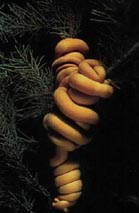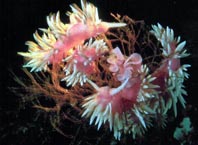By Apichart Panyadee
The rich and varied undersea life of New Zealand is matched by few places in the world. Sandwiched between two great ocean systems - the South Pacific and the
circum polar sea, which some call the Southern Ocean - its waters are peaceful; a temperate region lying between the lush coral tropics to the north, and the cold roaring seas to
the south.
Poor Knights Islands
Poor Knights Islands lie off the country’s North Island, and were named by James Cook in 1769. Captain Cook’s log reveals nothing as to the significance of
the name he bestowed on these islands, although it is sometimes thought it is a whimsical reference to a dish known as Poor Knights, which is made up of chunks of fried bread,
similar to French toast.
 New Zealand’s snake star
New Zealand’s snake star
Small and mountainous, casting dark shadows on the surrounding seascape, the two main islands once supported Maori fishing villages. Two decades ago, the New
Zealand government created an underwater sanctuary here, and today, no one lives on the islands.
The Poor Knights Islands are full of ancient volcanic tubes which have eroded into caves, rock castles, and archways. These unique underwater formations
provide an ideal habitat for marine life. A mollusk known as the clown nudibranch is found here. These creatures are hermaphroditic, which means they possess both female and male
reproductive capacity. Blennies swim in the pockets of the caves, and flying fish use the sea-castles for hatcheries. Here, divers will find the 18 inch long John Dory fish. Just
exactly how this fish got its name is not known. The tiny blue-eyed triple-fin is a feisty hunter of worms and crustaceans, and is only found in New Zealand waters. In the
perpetual gloom of the caves and tunnels, coupled with the constant flushing of the surrounding ocean, jewel anemones stretch their tentacles to snare passing plankton. This is a
rich feeding ground for all.
Fiordland National Park
During James Cook’s first voyage to New Zealand, he sighted an enchanting bay which he named Dusky Sound. Three years later, when he and his crew returned
from their harrowing Antarctic passage, it is here where they laid up and rested. They set up an observatory and also, it is written, a brewery which produces a product which is
described in Cook’s log as, “tasting for all the world like champagne”.
 A Nudibranch
A Nudibranch
Fiordland National Park covers more than three million acres. Glaciers sculptured these fjords to depths as much as 1,300 feet. As the ice retreated some 15,00
years ago, the sea flooded in. Westerly winds blowing across the Tasman Sea carry moisture up to the Fiordland’s mountains, making it one of the world’s wettest places.
Looking like a loaf of mouldy bread, the giant star gazer lives in these fjords, as well as some of the more than 600 known world wide sea spiders, and a most
unusual specimen called the snake star which thrives in the forests of black coral.
 Flying fish found only in New Zealand
waters
Flying fish found only in New Zealand
waters
Beneath the surface waters, the fjord’s vertical walls plunge into blackness. Black coral grows here like huge trees. Crustaceans always find sanctuary in
fjords. However, rock lobster and crayfish are not safe from the fisherman’s pots. Deep waters and shelf walls make setting the pots very difficult, but certainly worth the
effort, since the tails are exported around the world.
Steward Island
The famous Hooker’s sea lions breed off the coast of Steward Island. These are perhaps the rarest of sea lions, and during the mating season, sometimes the
headcount can be as high as 7,000 or more.
A fishing centre, Steward Island attracts a population of mollymawks, small albatrosses with wingspans of nearly eight feet. In these waters, the southern pig
fish extends its snout-like mouth to sweep crevices for worms and crustaceans, and the crimson flash of the topknot fish flashes by. The fishing piers create viable habitats for
creatures such as oysters, mussels and sponges which are easily scraped from the sides of the pilings. But under the surface of New Zealand’s exotic waters, the marine life
leads a secret life, about which most of us can only imagine.